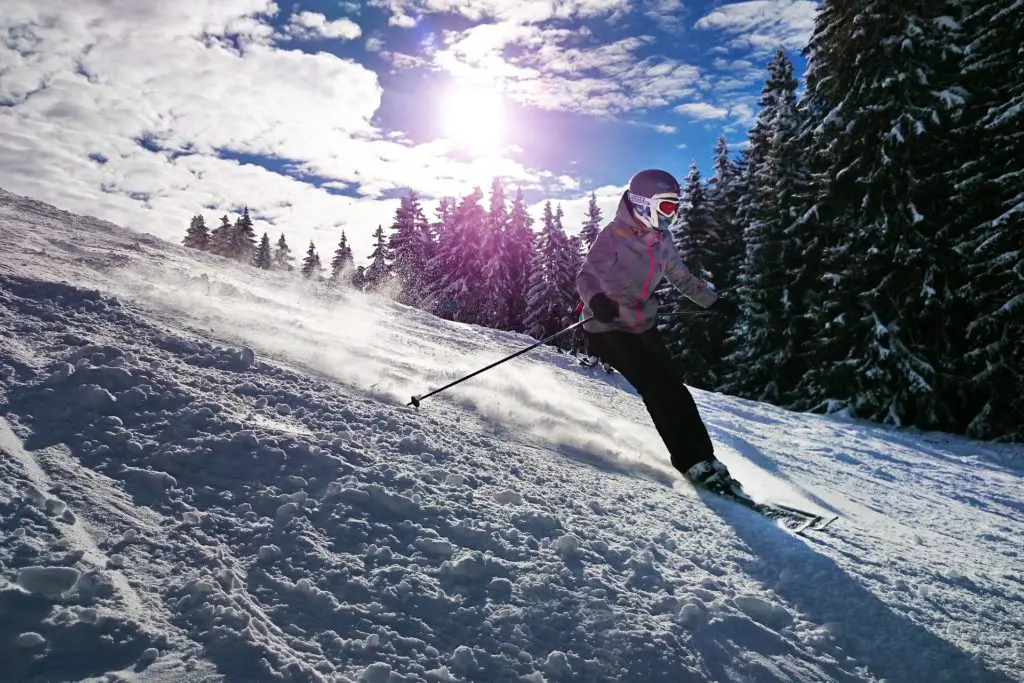If you are buying or renting your first pair of ski boots or becoming more of an advanced skier, you might be wondering which type of boot is best for you and why you might be advised to get different boots depending on your ability.
Its no secret that your ski boots are one of the most important pieces of equipment for not only your comfort, but to also help you improve and match your ability.
As you become more of an advanced skier, your skiing style is likely to change, along with the types of runs you attempt. Therefore, it is essential that your boots match not only you build but also your abilities and activities.
Beginner vs Advanced Ski Boots
Advanced ski boots are typically stiffer meaning they have a higher flex rating to give the skier more control and precision with their movements compared to beginner ski boots. Advanced ski boots also usually have a tighter fit and are more expensive.
| Beginner Ski Boots | Advanced Ski Boots |
| More flexible (lower flex rating) | Stiffer (higher flex rating) |
| Typically have a looser fit | Typically have a tighter fit |
| Less expensive | More expensive |
Why are Boots so Important?
Many skiers frequently hear that your boots are one of your most important pieces of equipment to make sure you not only have a great day out or holiday, but also to improve your technique. Many people think that getting the right boots for you is just to do with comfort, and this does play a big part!
If you are planning to be in your boots and skiing for most of the day, then you need to make sure that they’re comfortable so you can get the most out of the experience. For example, boots with too much flex for your ability and build can lead to you bending your knees too much and your muscles becoming fatigued quicker. However, it isn’t just about comfort, it is also about technique.
Boots can drastically determine the level of control you have over your skis, ability to turn and are even built for different speeds. Therefore, it makes sense that many aspects of boot design will alter relating to skiing ability.
What is Meant by Beginner and Expert?
This might seem like a simple question, but when deciding which are the best boots for you at your stage of skiing, it is important to know what exactly is meant by the terms beginner and expert, and what this assumed about your skiing habits.
If you are a beginner skier, is it assumed that you will be attempting less challenging slopes with a shallower gradient. You may be continuing to improve your technique and do not have a huge amount of experience on the slopes. Therefore, you might be having lessons and only attempting the nursery or shallowest slopes and generally travelling at slower speeds.
Intermediate skiers are likely to have better technique and be wanting to attempt more difficult and steeper slopes. This could also include trickier terrains such a moguls which might mean that the skier needs better control and precision of movement over their turns.
Advanced and expert skiers will likely be travelling at greater speeds and tackling the toughest slopes, such as black diamond slopes and mogul runs. Advanced skiers usually want great precision over their turns and complete control over their direction and movements, which can be helped by their boots!

What Features are Different?
Boot flex
Boot flex is one factor which you will be advised to consider depending on your ability when choosing a pair of boots. In general, more advanced skiers may require boots with a stiffer (or higher rating) boot flex.
This means that the boot will be less resistant to flexing forwards when you apply pressure with your shin on the front of the boot. This is measured by a flex index which is generally between 80 (lots of flex) and 150 (very stiff), although this index can change depending on the brand or type of boot you are looking for.
Generally, the stiffer the boot flex, the more precision and control you will have over your turns. This is why expert and advanced skiers tend to opt for a stiffer boot which may be more appropriate for them. Beginner skiers are likely to need boots with lower flex, allowing them to be comfortable while improving their technique and learning.
Check out my article on boot flex to learn more about this topic.
Boot fit
It is always important that your ski boots fit properly, not matter what your ability, and it may be beneficial to go to a professional boot fitter to make sure you are getting the exact right fit.
The precision of this fit may get more important the more advanced of a skier you become. Generally, as you become more advanced, you will require even greater control over your boots and skis to allow you precision of movement when turning and travelling at greater speeds. Therefore, a greater precision of the fit of the boot may have to be considered to provide this control over subtle movements.
How to Know Which Boots you Should Get?
When deciding on which ski boots are right for you, it is important to consider a range of factors. You will need to consider your height and weight as well as your ability and the types of slopes or terrain you plan to attempt. The right boots will allow you the right level of control over your skis which keeping you as comfortable as possible to enjoy some long days spent having fun on the slopes!
To Conclude
Lots of factors can influence the type of boot and the features you are likely to need as a skier. Your height, the terrain and also your ability can influence which is the right boot for you and some of this may be down to personal preference.
Generally speaking, advanced boots have a more precise fit and a stiffer flex compared to beginner boots, allowing skiers to have greater precision over their turns and control over their technique which are in line with their abilities.
Don’t forget to check out our other blogs about all the ski gear you might need for your first ski trip, or advice for more advanced skiers looking to improve their technique and want the best kit to help them with this!
Here are some more articles you might find useful:

